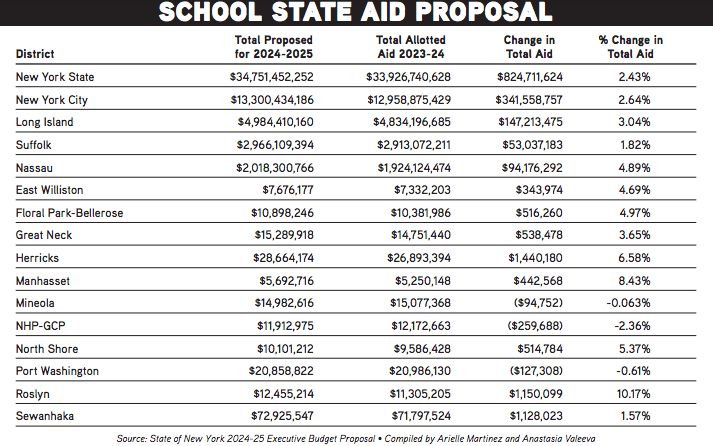
Long Island Republicans and North Shore school districts are pushing back against the governor’s state aid proposal for 2025, which would change the way education funds are handed out for school budgets as enrollment declines statewide.
“Because we’re not cutting fat, folks, we’re cutting bone,” New York State Sen. Jack Martins (R-Old Westbury) warned at a rally opposing the governor’s proposal.
Gov. Kathy Hochul’s 2025 budget proposal includes an allocation of $35.3 billion in state school aid. This is an increase of $825 million from the prior budget, or a rise of 2.4%, amounting to the highest proposal for school funding in the state’s history.
The $825 million proposed increase from budget to budget encompasses a $507 million rise in Foundation Aid – the state’s main education operating aid formula based on equity. The remaining $318 million increase is attributed to all other school aid programs.
The state’s foundation aid has historically included a hold harmless protocol, which is a standard that ensures school districts either receive the same or more foundation aid from year to year regardless of enrollment.
But the protocol would be removed from this budget under Hochul’s proposal, which the state budget director said would free up funds for high-need districts at a time when many school districts are flush with surplus funds as enrollment drops.
Impacted school districts include Manhasset, where the district’s superintendent said the drop in foundation aid and inflationary pressures would pose challenges in the budget for the next school year.
Under the proposal to remove the state’s save harmless initiative, Superintendent Gaurav Passi said Manhasset would face a decrease of $629,000 in its foundation aid.
The net losses for the district in total state aid, Passi said, amount to $511,000 – a 9.8% decrease.
“A half a million dollar reduction in state aid, coupled with significant increases in pension costs and retiree health care costs and very few retirements compound an already very challenging environment,” Passi said.
According to data from the governor’s proposal, Manhasset is projected to receive an 8.43% increase in total state aid, amounting to $5,692,716.
Some North Shore school districts would also see a drop in their overall state aid, including Port Washington, Mineola and New Hyde Park-Garden City Park.
Passi, who said he had consulted Martins on the issue, asked the community to write letters to the governor, Martins and state Assemblywoman Gina Sillitti.
The school district drafted its own letter to the public officials about its concerns, advocating against the proposed decrease in state aid as it is “too much to bear.”
Long Island Republicans held a rally last week opposing the governor’s proposal for school aid, saying it cuts $23 million in aid to Nassau County schools.
Martins advocated at the rally for the state to fund at least 20% of school districts’ budgets, saying some districts in his constituency do not meet that minimum.
Martins and New York 3rd Congressional District candidate Mazi Pilip have opposed the governor’s proposal in light of her allocation of $2.4 billion to address the current migrant crisis. Republicans argue that the funding for the migrant crisis is directly affecting school funding.
Blank Slate Media requested comment from Martins on the issue but did not receive a response by the time of publication.
An op-ed written by state Division of Budget Director Blake Washington applauds the governor’s investment in schools and says her funding of schools is unprecedented.
“Instead of asking the question, ‘how much more money are our schools getting?’ it should be ‘why do we have a formula that forces us to pay for students that don’t exist?’” Washington wrote. “These are the hard conversations where the governor is trying to inject common sense as we engage with districts, families, the Legislature, and stakeholders in this upcoming budget. Only then can we find real, sustainable solutions that New York taxpayers rely on while also ensuring our teachers get the resources they need to educate the next generation of New Yorkers.”
He praised the governor was for her full funding of the state’s foundation aid formula – the first since its establishment 15 years ago.
“Simply put, no governor in New York State history has invested more in education than Gov. Hochul,” Washington writes.
The New York State aid formula for schools is based on factors that evaluate enrollment, student need and district wealth.
Washington said the hold harmless initiative disregards district wealth, student needs or population changes and opposes the foundation aid formula as it limits state resources for high-need or growing school districts.
“Investing in this manner ensures that the state of New York prioritizes its resources to the districts that need it most,” Washington wrote.
He said that school districts are receiving funds “faster than they can actually spend it,” attributing this claim to “exponential increases” over this period of time that have boosted district reserves.
Washington said statewide fund balances have increased by $2.7 billion in the past three years, amounting to $10.5 billion, or 24% of districts’ budgets. Districts now have surplus reserves of almost $1 billion, Washington said, which exceeds statutory limits.
“At a time of record cash on hand for most districts, common sense dictates that the Executive Budget begin a conversation around how to address this difficult question in the long term, while at the same time allowing the state to continue its investments in the many other services that New York families rely upon,” Washington wrote. “Taxpayers should expect no less.”
He said schools have seen an increase of $20 billion in aid over the past three years, attributed to the state’s budget and $13 billion in federal aid.
Washington said New York spends more than $26,500 per pupil, which exceeds the national average by about 85%.
Coupled with this is a 10% drop in school enrollment since 2014, Washington said.
“At a time when hard decisions are required to close a significant budget gap, these factors must be part of the equation,” Washington wrote.






